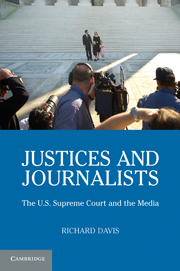7 - The Twenty-First Century and the Future
Published online by Cambridge University Press: 05 June 2012
Summary
In 2000, Justice Clarence Thomas delivered a speech before a high school group and told the students that “the last political act we engage in is confirmation.” Thomas' statement was not that surprising. Despite a long history of political involvement by their predecessors, at least some justices today still like to perpetuate the myth that what they do has nothing to do with politics.
Nor is it the case that things have changed – that political involvement has become a thing of the past for twenty-first-century justices. It is highly unlikely that is the case. Of course, the extent of the current justices' political involvement is difficult to assess because of the shroud the justices place over their interactions. Obviously, scholars today lack the access to the papers of justices in the twenty-first century who have not retired or even those who have recently retired. It is likely to be many years before the papers of William Rehnquist, Sandra Day O'Connor, and John Paul Stevens become accessible. For example, only in 2010 did the papers of Potter Stewart become available to scholars. Stewart, who retired in 1981 and died in 1986, had stipulated that his papers remain closed until all justices who had sat with him had left the bench. John Paul Stevens, who retired in 2010, was the last of those justices who served with Stewart.
- Type
- Chapter
- Information
- Justices and JournalistsThe U.S. Supreme Court and the Media, pp. 170 - 196Publisher: Cambridge University PressPrint publication year: 2011
- 1
- Cited by



